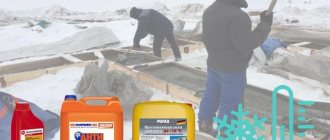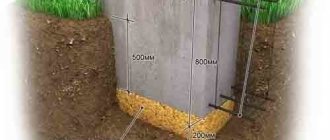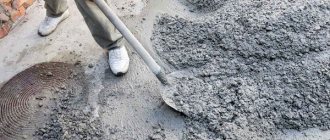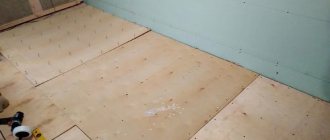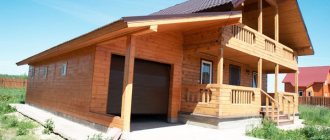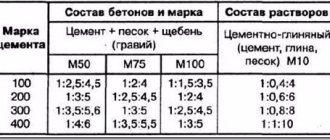Traditionally, “wet” processes include all activities related to the construction of buildings and structures that are associated with concreting, masonry work, plastering, etc. One of the main components necessary for preparing concrete mixtures and solutions directly on the construction site is water, which freezes at subzero temperatures.
In this part of the training course, we will talk about what nuances need to be taken into account when carrying out “wet” work in winter and how to properly use antifreeze additives.
What conditions are considered “winter” when concreting and masonry work?
Before you understand what features and limitations entail negative temperatures during “wet” processes, you need to understand what is meant by winter concreting conditions.
Many people believe that winter conditions are conditions in which the outside temperatures are consistently below freezing and it is snowing. Actually this is not true. In accordance with SP 70.13330.2012 “Load-bearing and enclosing structures”, winter conditions are when the average daily outside air temperature is below +5 °C, or the minimum daily temperature is below 0 °C .
That is, as you can see, the concept of “winter” conditions covers a wide range of temperatures. They can occur, depending on the region of residence, both in autumn and early spring, and without precipitation in the form of snow.
There is also a widespread belief among novice developers that at subzero temperatures, and even more so if the thermometer drops below -15...-25 °C, it is impossible to pour a foundation or lay wall cladding. Although, if you look at commercial construction, work on the construction of monolithic high-rise buildings and residential apartment buildings is carried out all year round, regardless of weather conditions.
This is due to the use of special concreting techniques and the use of special anti-frost additives - chemicals that modify the concrete mixture.
Features of winter concreting and masonry work
To understand how antifreeze additives work and what are the advantages of using them, you need to imagine what happens to concrete or masonry mortar if you build in winter.
Kirill Lebedev Technical specialist at SIKA
At subzero temperatures, the water contained in concrete or masonry mortar begins to freeze. As a result, ice crystals form. Moreover, when water freezes, it expands (by approximately 7-9%) and destroys the structure of concrete, which has not yet achieved the required grade strength. Those. the process of cement hydration, which is only possible at positive temperatures, stops. Accordingly: concrete or mortar does not harden, but freezes.
If in this state the foundation or masonry “went into winter,” this will lead to dire consequences. Frozen water, not having time to fully react with the astringent components of the mixture, turns into a liquid state again with the onset of a thaw. Although the chemical process of interaction between cement grains and water continues, the destroyed structural bonds in concrete are not completely restored. In addition, water, freezing around the metal reinforcement (the colder zone during concreting), forms an ice film, increases in volume and, under pressure, squeezes the cement gel from the reinforcement frame.
As a result, the grade strength of concrete is significantly reduced (about 50% of the calculated value). Also, due to internal stresses and shrinkage, cracking of the foundation structure may occur with a complete loss of bearing capacity.
If, for example, facing bricks are laid at subzero temperatures, then the mixture, due to the small layer and additional, rapid cooling when interacting with cold stone, quickly freezes. Its plasticity is lost, horizontal seams remain insufficiently compacted. The mixture is actually held together by the ice.
The so-called is based on this method. freezing masonry method, when it is planned that when the mixture thaws in the spring, the hardening process of the solution will continue. But the risks outweigh the benefits. When thawing, the masonry mortar, which does not yet have sufficient strength, shrinks due to the weight of the overlying masonry. Uneven shrinkage occurs, leading to loss of stability and further destruction of the lining.
Insulation of concrete floor
Concrete is a durable material from which most floors are made. However, it has one significant drawback - high thermal conductivity. To reduce heat losses in an apartment, house or bathhouse, you need to know how to insulate a concrete floor while maintaining its positive qualities.
- Choice of insulation
- Calculation part
- Concrete floor insulation technologies
- Continuous layer
- Frame method
- Under the screed
- Common mistakes
How to get quality concrete in winter
Ambient temperature is one of the main factors influencing the strength gain of concrete. It is believed that the optimal conditions for concrete to gain strength are the temperature range from +18 °C to + 20 °C. In this case, the concrete will gain 70% of its original strength in approximately 10 days, and 100% in 28 days. At a temperature of +5 °C, the strength of concrete increases approximately 3-4 times slower. It will gain strength of 70% of the brand name in about 15 days, and will gain 100% much longer than the required 28 days. When the temperature drops to 0 °C, the hardening of concrete and masonry mortar practically stops, and at lower temperatures it stops. The question arises how to circumvent the above problems.
Kirill Lebedev
There are several ways to carry out concrete and masonry work in winter. For example, related to the heating of building structures, the use of heat guns, electrical heating of freshly laid concrete, the construction of greenhouses, the use of the “thermos” method, the so-called. “warm” (heated) concrete mixtures. The use of antifreeze does not cancel the use of these methods, but it can significantly reduce the time it takes for concrete to gain strength, and, therefore, save time and money.
Antifreeze additives work in a comprehensive manner: they reduce the freezing point of water, and complex additives also reduce the required amount of mixing water; accelerate the hardening process of the mixture at low temperatures (down to -25 ° C); increase the workability of the mixture and the grade strength of concrete.
Important point : according to SP 70.13330, as part of the preparatory work associated with concreting, measures should be taken that prevent freezing of the concrete mixture when transporting it in a mixer to the place of laying and until critical strength is achieved.
At the same time, antifreeze additives should not have a negative effect on the reinforcement. Moreover, the “Code of Rules” prescribes the use of antifreeze both when using “warm” concrete and using heating systems, and when laying a “cold” mixture.
The main advantage of antifreeze additives is that they allow concrete to quickly reach critical strength at which it can be frozen without negative consequences.
The main increase in strength of the freshly laid mixture occurs in the first 3-5 days. Therefore, it is critical to prevent the concrete from freezing during this period, which is what antifreeze additives can do. In addition, complex antifreezes are economical to use and reduce cement consumption. This allows you to reduce construction costs without losing quality.
Is it possible to concrete in cold weather?
First, let’s figure out whether it’s possible to concrete in cold weather. With low temperatures already falling below zero, you shouldn’t stop your work, that’s for sure. Just use concrete mortar with special frost-resistant additives, which are sold at any hardware store. And the next step, be sure to wrap the fill with a covering material - the simplest one, which can be branches or construction debris.
How does cement mortar behave in cold weather?
Let's see how frost affects concrete. In the usual classic version of concrete mortar, as a rule, all the main components are mixed with water, which is the main problem. The water freezes and destroys the formative integrity of the solution. Here the strength and, accordingly, the reliability of such a mixture are reduced to zero.
Therefore, during the pre-winter and winter period of construction of buildings, it is imperative to mix special plasticizers into the cement composition, which can easily eliminate such problems.
The nuances of using antifreeze additives
It was already mentioned above that SP 70.13330 regulates the use of antifreeze additives. The fact is that antifreezes contain salts, and some additives, due to the presence of chlorides, can cause serious corrosion of steel reinforcement.
Each manufacturer has its own selection of additive components, but the main thing that a developer should remember when purchasing antifreeze additives is that he must choose a quality product from a well-established manufacturer. It should be written on the product packaging that the use of anti-frost additives in reinforced concrete structures is allowed.
Kirill Lebedev
If anti-frost additives are not used correctly in masonry mortars, in the spring, white stains (efflorescence) may appear on the facing brickwork. Therefore, you should strictly adhere to the manufacturer’s recommendations and use the dosage of antifreeze in strict accordance with the instructions.
Conclusions: The use of anti-frost additives ensures the continuity of the construction process at any external temperature and guarantees the quality and long service life of a country house. Although negative temperatures lead to increased costs associated with shorter working hours, additional costs for lighting, the need to heat workers and structures, etc., in winter prices for building materials, construction services, and equipment rentals decrease slightly. The cost of additives in the overall estimate for building a house is small. Therefore, with a competent approach, it is possible to bring the price of construction in winter and the price of construction in summer to a common denominator.


